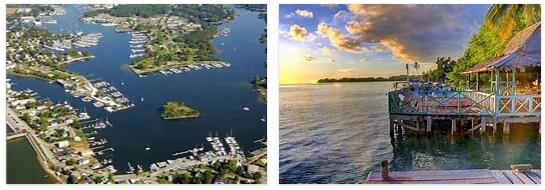Solomon Islands, state in the western Pacific. It includes the Solomon Islands northeast of Australia (apart from the two northern islands of Bougainville and Buka, which belong to Papua New Guinea) and a few other islands. The capital Honiara is located on the largest island of Guadalcanal. About 95% of the residents are Melanesians. The most important economic products are copra and wood. The rich natural resources have not yet been tapped, and industry is poorly developed.
History: The former British Isles gained independence in July 1978. You are a member of the Commonwealth. The head of state is the British monarch, represented by a governor general.
Location
The national territory consists of six large and hundreds of smaller islands, atolls and reefs, which extend in two parallel chains over around 1,500 km in the western Pacific Ocean. The main islands of Guadalcanal (5,302 km 2), San Cristóbal (3 188 km 2), Santa Isabel (4 662 km 2), Malaita (4 071 km 2), New Georgia (1,800 km 2) and Choiseul (2 538 km 2) are of volcanic origin (often earthquakes), mountainous (on Guadalcanal in Popomanaseu 2,335 m above sea level) and surrounded by coral islands and atolls. Guadalcanal has an extensive coastal plain.
Politics
According to the constitution, which came into force on July 7, 1978, the Solomon Islands are a parliamentary monarchy in the Commonwealth. The head of state is the British monarch, represented by a local governor-general appointed on the proposal of Parliament. The legislature rests with the unicameral parliament (50 members, elected for 4 years by majority vote), the executive with the government under the chairmanship of the prime minister elected by the parliament. The remaining members of the cabinet responsible for parliament are appointed by the governor general on the proposal of the head of government.
National symbols
The national flag was adopted on November 18, 1977 before independence. The cloth is divided diagonally by a yellow stripe, the resulting triangles are blue at the leech and green at the flying end. The yellow stripe takes up an eleventh of the flag width. On the leech there are five five-pointed stars for the number of former districts. Blue symbolizes the sea, but also the rain, which allows the tropical vegetation, represented in the green of the flag, to flourish. Yellow stands for the sun, white for the sandy beaches.
The coat of arms was introduced with independence on July 7, 1978. In the blue head of the shield it shows a natural-colored eagle, heraldically looking to the right, flanked by two frigate birds in flight. The golden lower part of the shield is divided by a green St. Andrew’s cross. Both cross bars are covered with a Melanesian harpoon, the center is a light brown dance shield, behind which arrows and bows protrude. The two sideways fields each carry a turtle. A crocodile (heraldic right) and a shark serve as shield holders. The upper coat of arms consists of a blue-silver helmet cover and a bulge, on which lies a traditional Solomon Islands boat, the bow and stern of which are framed by a golden sun in the shape of a compass rose.
The national holiday is July 7th. It commemorates independence in 1978.
Parties
There is no stable party system; independent candidates dominate parliament. Important parties are the Democratic Alliance Party (DAP), United Democratic Party (UDP), People’s Alliance Party (PAP), Solomon Islands Party for Rural Advancement (SIPRA) and Ownership, Unity and Responsibility Party (OUR Party).
Unions
Workers’ organizations first emerged in the 1960s. The umbrella organization of the 14 trade unions is the Solomon Islands Council of Trade Unions (SICTU; founded 1986).
Military
The island state does not have its own armed forces.
Administration
The island state is administratively divided into 9 provinces (with elected parliaments and governments) and the capital district (with its own city council).
Law
Sources of law are parliamentary laws, supplemented by unwritten English law (common law and equity). The High Court has general jurisdiction over civil and criminal matters and is the appellate authority for decisions of the magistrate courts. The higher authority is the appellate court. Local disputes are settled by the village head or local courts.
Education
There is no compulsory schooling, but the enrollment rate at primary schools (6-11 years of age) is around 97%. Further education is provided by three to five-year secondary schools, at which the school enrollment rate is around 30%. According to andyeducation, the Solomon Islands have the Solomon Islands College of Higher Education (founded in 1884) and a department of the University of the South Pacific (USP, founded in 1971) in Honiara.
Media
Press: The largest daily newspapers are »Solomon Voice« (founded in 1992) and »Solomon Star« (founded in 1982). In addition, the weekly newspaper “Solomon Times” and the government paper “Solomon Nius” appear monthly.
Broadcasting: The Solomon Islands Broadcasting Corporation (SIBC; founded in 1976) broadcasts radio programs in English and pidgin and, since 1996, a television program. There are also two commercial radio stations.
